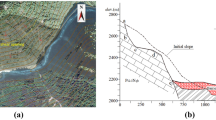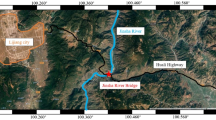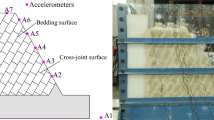Abstract
The mechanisms and characteristics of earthquake-triggered anti-dip rock landslides remain largely unknown. In this study, the dynamic response characteristics and failure process of anti-dip layered rock slopes are investigated under strong earthquake conditions using shaking table model tests and numerical analysis. The test model uses a slope angle of 60° and steep dip angle of 75° and considers different vibration waveforms, frequencies, amplitudes, and durations. Under the same conditions, the seismic wave PGA amplification factor is higher than that of a sine wave. Under the action of the two waveforms, the PGA amplification factor increases nonlinearly with elevation owing to the interaction of the elevation amplification effect and inhibition of the slope toe. The frequency is greater than or equal to the natural frequency of the test model, but the increase is not notable below 3/5 of the slope height. Horizontally, the PGA amplification factor is larger on the top and surface of the slope. The peak PGA amplification factor shifts from the surface to the top with increasing amplitude. With increasing frequency, the PGA amplification factor reaches a peak value at the natural frequency and then decreases. Frequency has a stronger influence on the dynamic slope response than amplitude, and duration has the weakest influence. The dynamic slope failure model results show that the failure mode of an anti-dip rock slope under a seismic load involves the extension of shear cracks and tension cracks and development of step-type fractures, which trigger slope toppling and sliding failure.










Similar content being viewed by others
Availability of data and material
The datasets used or analyzed during the current study are available from the corresponding author on reasonable request.
References
Aydan Ö (2016) Large rock slope failures induced by recent earthquakes. Rock Mech Rock Eng 49:2503–2524. https://doi.org/10.1007/s00603-016-0975-3
Castelli F, Lentini V, Ferraro A, Grasso S (2018) Seismic risk evaluation for the emergency management. Ann Geophys 62(2). https://doi.org/10.4401/ag-7705
Castelli F, Grasso S, Lentini V, Sammito MSV (2021) Effects of soil-foundation-interaction on the seismic response of a cooling tower by 3D-FEM analysis. Geosciences 11(5):200. https://doi.org/10.3390/geosciences11050200
Che AL, Ge XR (2012) Earthquake-induced toppling failure mechanism and its evaluation method of slope in discontinuous rock mass. Int J Appl Mech 04:1250036. https://doi.org/10.1142/S1758825112500366
Del Gaudio V, Wasowski J (2007) Directivity of slope dynamic response to seismic shaking. Geophys Res Lett 34:L12301. https://doi.org/10.1029/2007GL029842,2007
Dong JY, Yang GX, Wu FQ, Qi SW (2011) The large-scale shaking table model test study of dynamic response and failure mode of bedding rock slope under earthquake. Rock Soil Mech 32: 2977–2982+2988
Dong JY, Yang JH, Wu FQ, Yang GX, and Huang ZQ (2013) Large-scale shaking table model test research on acceleration response rules of bedding layered rock slope and its blocking mechanism of river. Chin J Rock Mech Eng z2: 3861–3867
Editorial Board of the Engineering Geology Manual (2018) Geological engineering handbook, 4th edn. China Construction Industry Press, Beijing
Fan G, Zhang JJ, Wu JB, Yan KM (2016) Dynamic response and dynamic failure mode of a weak intercalated rock slope using a shaking table. Rock Mech Rock Eng 49:3243–3256. https://doi.org/10.1007/s00603-016-0971-7
Feng XX, Jiang QH, Zhang XB, Zhang HC (2019) Shaking table model test on the dynamic response of anti-dip rock slope. Geotech Geol Eng 37:1211–1221. https://doi.org/10.1007/s10706-018-0679-4
Gali M, Garaga A (2010) Seismic stability analysis of a Himalayan rock slope. Rock Mech Rock Eng 43(6):831–843. https://doi.org/10.1007/s00603-010-0088-3
Huang RQ, Li G, Ju NP (2013a) Shaking table model test on strong earthquake response of stratified rock slopes. Chin J Rock Mechan Eng 32:865–875
Huang RQ, Zhao JJ, Ju NP, Li G (2013b) Analysis of an anti-dip landslide triggered by the 2008 Wenchuan earthquake in China. Nat Hazards 68:1021–1039. https://doi.org/10.1007/s11069-013-0671-5
Hung RQ, Pei XJ, Cui SH (2016) Cataclastic characteristics and formation mechanism of rock mass in sliding zone of Daguangbao landslide. Chin J Rock Mechan Eng 35:1–15. https://doi.org/10.13722/j.cnki.jrme.2015.0075
Ka MC, Chen RS, Wu WJ, Liu G (2011) Analysis on features of earthquake—induced landslide in heavy layer and antidip stratified rock slope. Northwestern Seismological Journal 33:408–412
Li LQ, Ju NP, Zhang S, Deng XX (2017) Shaking table model test to assess seismic response differences between steep bedding and toppling rock slopes. Bull Eng Geol Env 78:519–531. https://doi.org/10.1007/s10064-017-1186-1
Li Xianglong (2013) Research of the seismic-induced failure mechanism of layered rock high slope Dissertation, China University of Geosciences
Li ZS, Ju NP, Hou WL, Li G (2012) Large scale shaking table model tests for dynamic response of steep stratified rock slopes. J Eng Geol 20:242–248
Liu H, Xu Q, Li YR (2014a) Effect of lithology and structure on seismic response of steep slope in a shaking table model test. J Mt Sci 11:371–383. https://doi.org/10.1007/s11629-013-2790-6
Liu L, Chen L, Cui ZH, Li H (2014b) FLAC/PFC2D hybrid simulation for seismically induced failure process of toppling rock slope. J Eng Geol 1257–1262. https://doi.org/10.13544/j.cnki.jeg.2014.06.033
Liu LB, Li HB, Liu YQ (2017) Ground motion amplification effect of high and steep slopes. Journal of Yangtze River Scientific Research Institute 34:98–103
Luo YH, Wang YS, Wang FH, Deng X (2010) Monitoring of slope seismic response during aftershocks of wenchuan earthquake in Qingchuan county. J Eng Geol 18:27–34
Mi Y, Wang JH (2020) Finite-element modeling of submarine landslide triggered by seismic loading in saturated cohesive soil deposits[J]. Bull Eng Geol Env 2020:1–15. https://doi.org/10.1007/s10064-020-02005-4
Miki S, Sasaki T, Koyama T, Nishiyama S, Ohnishi Y (2010) Development of coupled discontinuous deformation analysis and numerical manifold method (NMM-DDA). Int J Comput Methods 7(01):131–150. https://doi.org/10.1142/S021987621000209X
Newmark NM (1965) Effects of earthquakes on dams and embankments. Géotechnique 15:139–160
Shi ZM, Xiong X, Peng M, Zhang LM, Zhu Y (2016) Risk assessment and mitigation for the Hongshiyan landslide dam triggered by the 2014 Ludian earthquake in Yunnan, China. Landslides 14:269–285. https://doi.org/10.1007/s10346-016-0699-1
Tian YY, Xu C, Xu XW, Wu SE, Chen J (2015) Spatial distribution analysis of coseismic and pre-earthquake landslides triggered by the 2014 Ludian MS 6.5 Earthquak. Seismology and Geology 37:291–306
Trifunac M, Hudson DE (1971) Analysis of the Pacoima dam accelerogram—San Fernando, California, earthquake of 1971. Bull Seismol Soc Am 61:1393–1411
Wu DH, Liu YQ, Li HB, Xia X, Peng B, Sheng H (2020) Shaking table model tests on dynamic amplification and failure mechanism of layered rock slopes under seismic actions. Chin J Rock Mechan Eng 39:1945–1956
Xu C, Dai FC, Xu XW (2010a) Wenchuan Earthquake-Induced landslides:an Overview Geological Review 56:860–874
Xu Q, Liu HX, Zou W, Fan XM, Chen JJ (2010b) Large—scale shaking table model test study of acceleration dynamic responses characteristics of slopes. Chin J Rock Mechan Eng 29:2420–2428
Yan ZX, Gao L, Peng NB, Ren ZP, Guo B (2012) Study of dynamic response of bedding rock slope under earthquakes. Rock Soil Mech 33:85–90
Yang GX, Wu FQ, Dong JY, Qi SW (2012a) Study of dynamic response characters and failure mechanism of rock slope under earthquake. Chin J Rock Mechan Eng 31:696–702
Yang GX, Ye HL, Wu FQ, Qi SW, Dong JY (2012b) Shaking table model test on dynamic response characteristics and failure mechanism of antidip layered rock slope. Chin J Rock Mechan Eng 31:2214–2221
Yang XY, Yao YH, Tian YT (2018) Development law and distribution characteristics of geological hazards after “8· 3” earthquake in Ludian, Yunnan. Science Technology and Engineering 18:16–21
Yao X, Xu C, Dai FC, Zhang YS (2009) Contribution of strata lithology and slope gradient to landslides triggered by Wenchuan Ms 8 earthquake, Sichuan, China. Geol Bull China 28:1156–1162
Funding
This study was supported by the National Key Research and Development Program (Grant No. 2019YFC1509704) and the National Natural Science Foundation of China (Grant No. U1704243).
Author information
Authors and Affiliations
Corresponding author
Ethics declarations
Conflict of interest
The authors declare no competing interests.
Rights and permissions
About this article
Cite this article
Liu, H., Zhao, Y., Dong, J. et al. Experimental study of the dynamic response and failure mode of anti-dip rock slopes. Bull Eng Geol Environ 80, 6583–6596 (2021). https://doi.org/10.1007/s10064-021-02313-3
Received:
Accepted:
Published:
Issue Date:
DOI: https://doi.org/10.1007/s10064-021-02313-3




